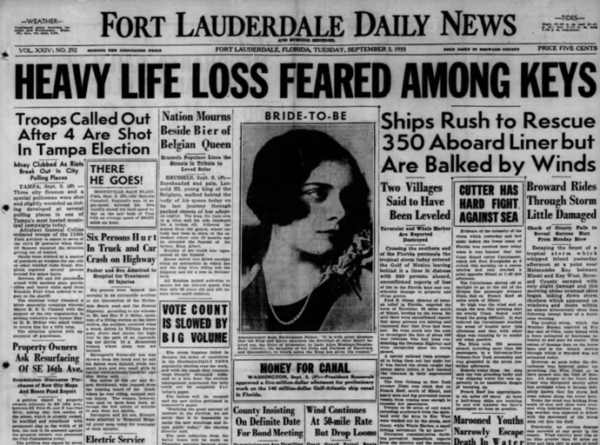Today is the Anniversary of the Labor Day Hurricane of 1935
The Labor Day Hurricane struck the Florida keys on this date in 1935.
Weather reports from Cuba during the day before alerted forecasters that the hurricane was strengthening, but there was no way to tell that it would become one of the strongest hurricanes in recorded history. The barometric pressure measured at Long Key remains the second-lowest pressure reading ever measured in the Western Hemisphere (26.35 inches/892 mb) and the lowest observed in the United States.
Winds were 185 mph with gusts exceeding 200 mph. Tides reached 15 feet above normal.
Henry Flagler had built his Florida East Coast Railroad from Miami to Key West several years before. As part of the Works Progress Administration program of the New Deal, 700 men were working to build a highway alongside Flagler’s railroad to Key West. Officials in charge of evacuating the veterans did not move quickly enough to get the veterans off the vulnerable islands.
Incomplete and misunderstood information from the U.S. Weather Bureau contributed to the slow reaction. The Weather Bureau did not know how strong the storm became in the hours before landfall, missed its position by over 100 miles and did not stress the danger to the Florida Keys strongly enough. Weather Bureau advisories repeatedly stated that the hurricane would pass south of the Keys.
Officials did not make arrangements early enough for an evacuation train. The officials thought that a train could be ordered to the veteran’s camps in four hours. They did not know it took time to assemble the train, get a crew and at least two hours to fire up the boilers and get enough steam to get the train moving.
When the train finally started south from Miami about 4:25 p.m., weather conditions had already deteriorated and the storm center was nearly onshore. Windblown debris on the track and an open drawbridge delayed the train even further. The train never reached most of the people it was sent to rescue.
At 4:30 p.m., Weather Bureau advisories recognized that the hurricane was further north than they had earlier thought, but it was, of course, too late.
Officially, 408 people lost their lives as a result of the storm, including over 250 veterans, but the death toll may have actually been much higher. Following the storm, the Florida East Coast railroad was abandoned, but the Overseas Highway would eventually be completed and still stands today.
PROGRAMMING NOTE: Hear Author Willie Drye talk about his excellent book on the hurricane along with 1935 hurricane expert Greg Nordstrom from Mississippi State University on this week’s WeatherBrains podcast. The show will be recorded tomorrow night.
Category: ALL POSTS, Met 101/Weather History
















